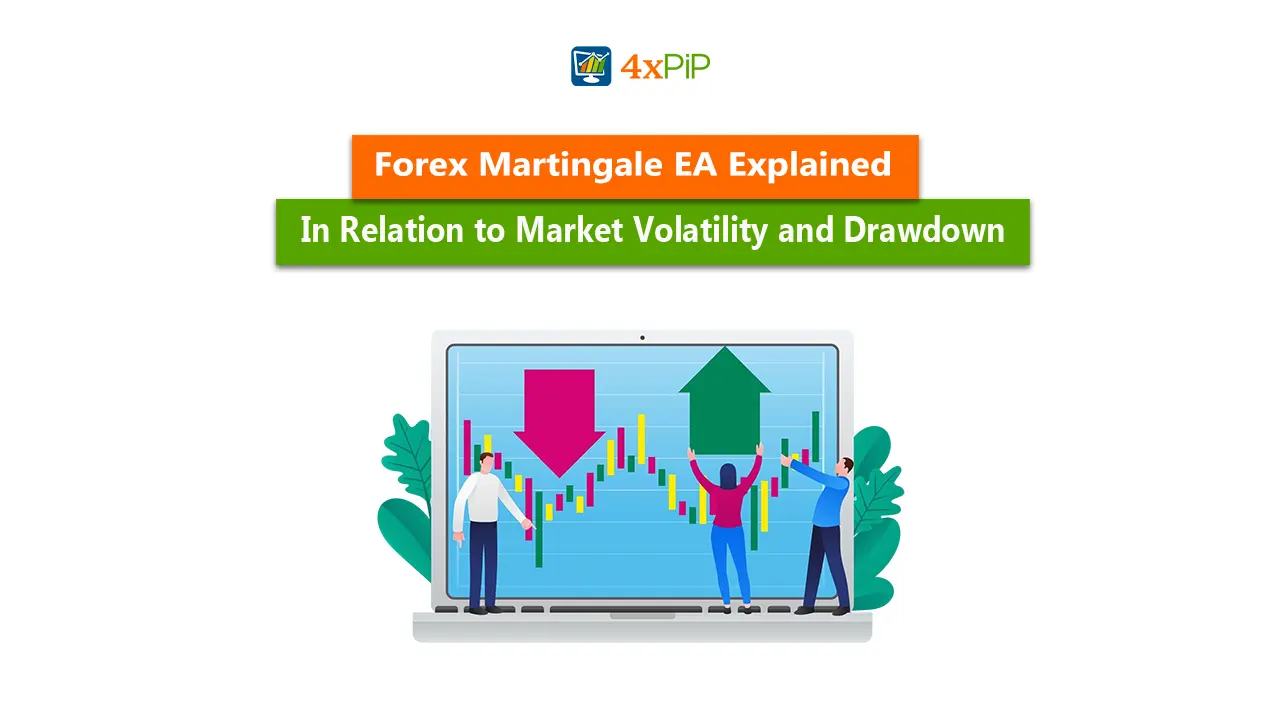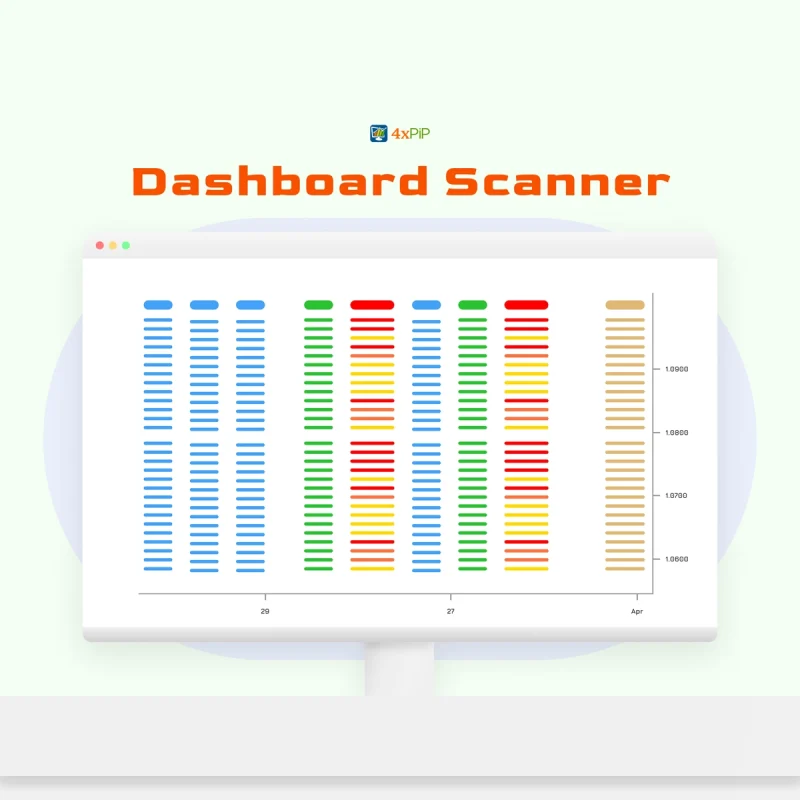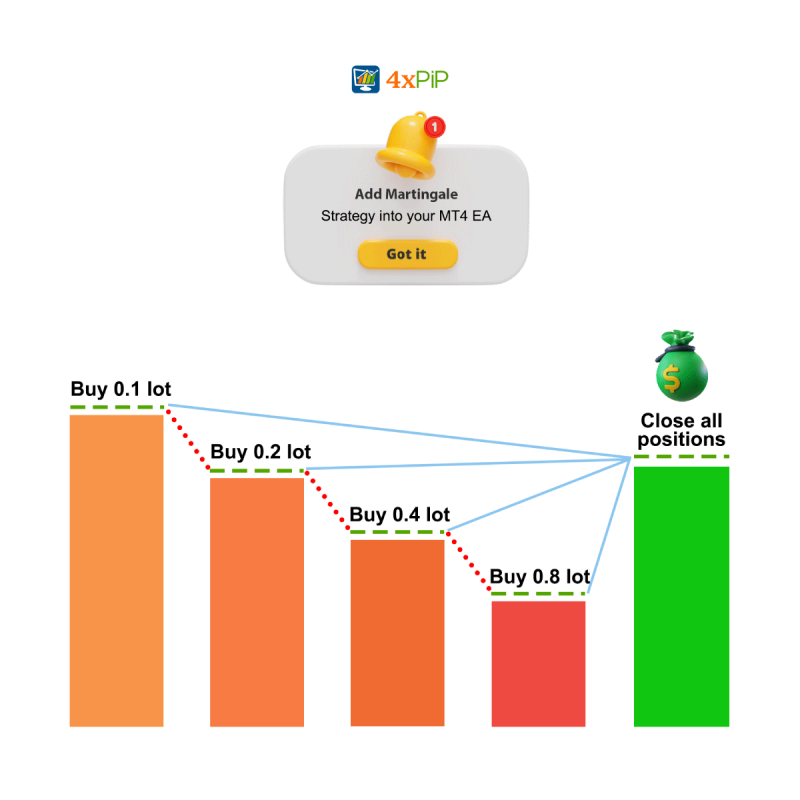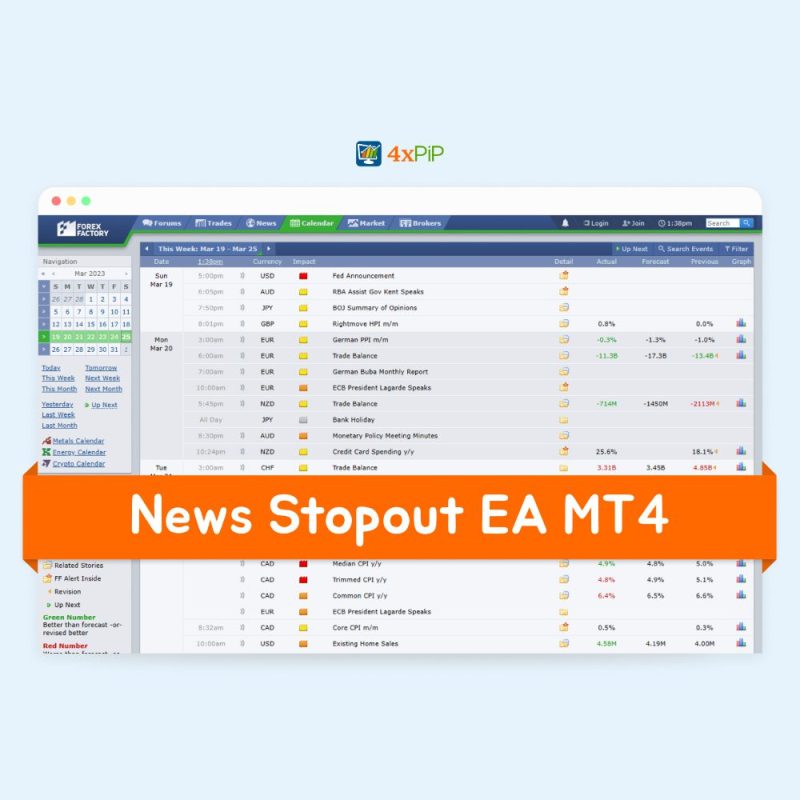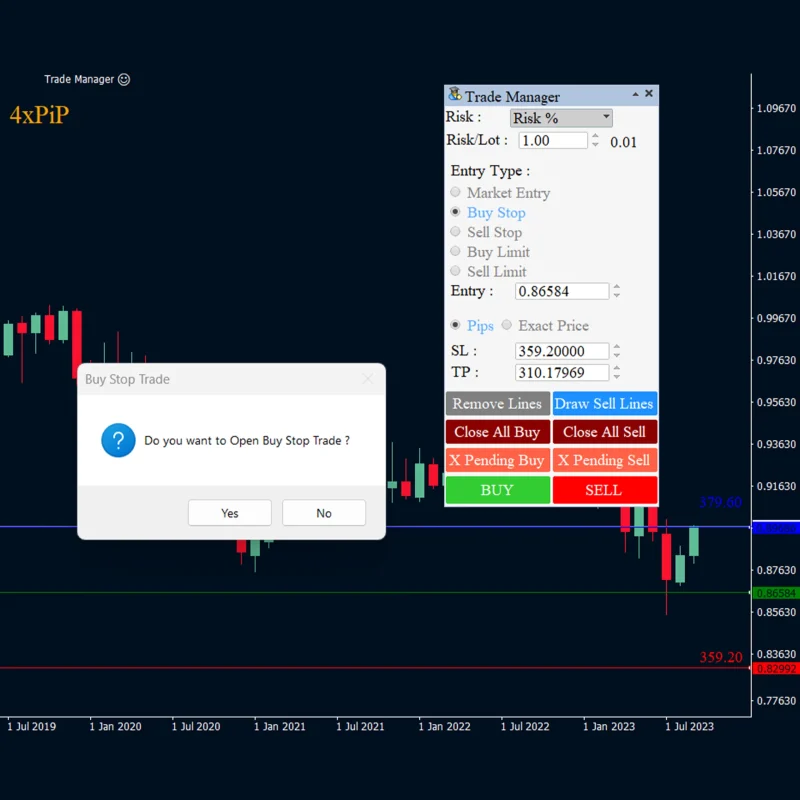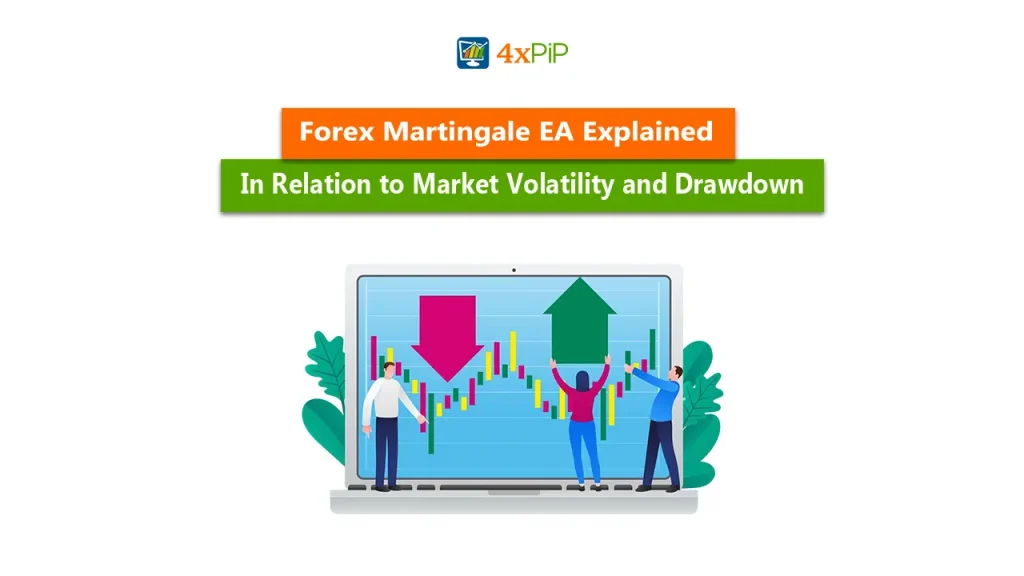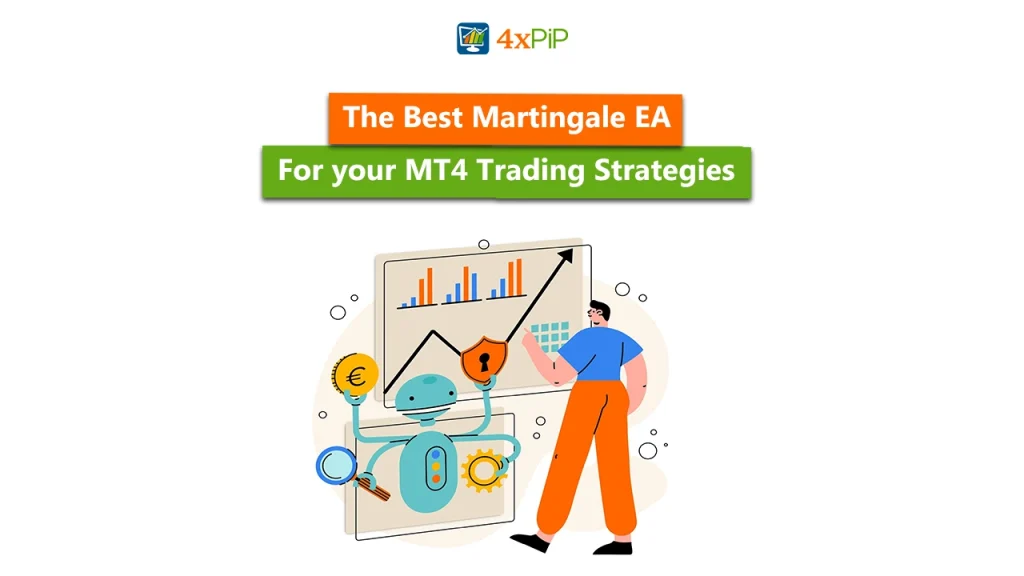A Forex Martingale EA (Expert Advisor) operates on the principle of doubling trade size after a losing position, with the goal of recovering prior losses once a profitable trade occurs. This compounding method works through grid-based trading, where new positions are opened at set price intervals, known as steps, allowing the EA to average out entries and exit at a collective profit. However, while this technique can generate consistent short-term gains, its sustainability depends heavily on market volatility and drawdown management. When volatility expands without sufficient margin or control mechanisms, the strategy can magnify losses faster than it recovers them.
The relationship between Martingale logic, volatility, and drawdown lies at the heart of risk-controlled automation. Traders using systems like the Martingale Forex EA from 4xPip can optimize parameters such as equity stops, grid spacing, and volatility filters to regulate exposure. Equity stops help define a clear loss threshold, grid spacing determines trade intervals under varying volatility, and volatility filters restrict entries during erratic market swings. Together, these controls transform a high-risk averaging system into a more sustainable automated strategy that balances recovery potential with capital preservation.
The Core Principle of the Martingale Strategy in Forex Trading
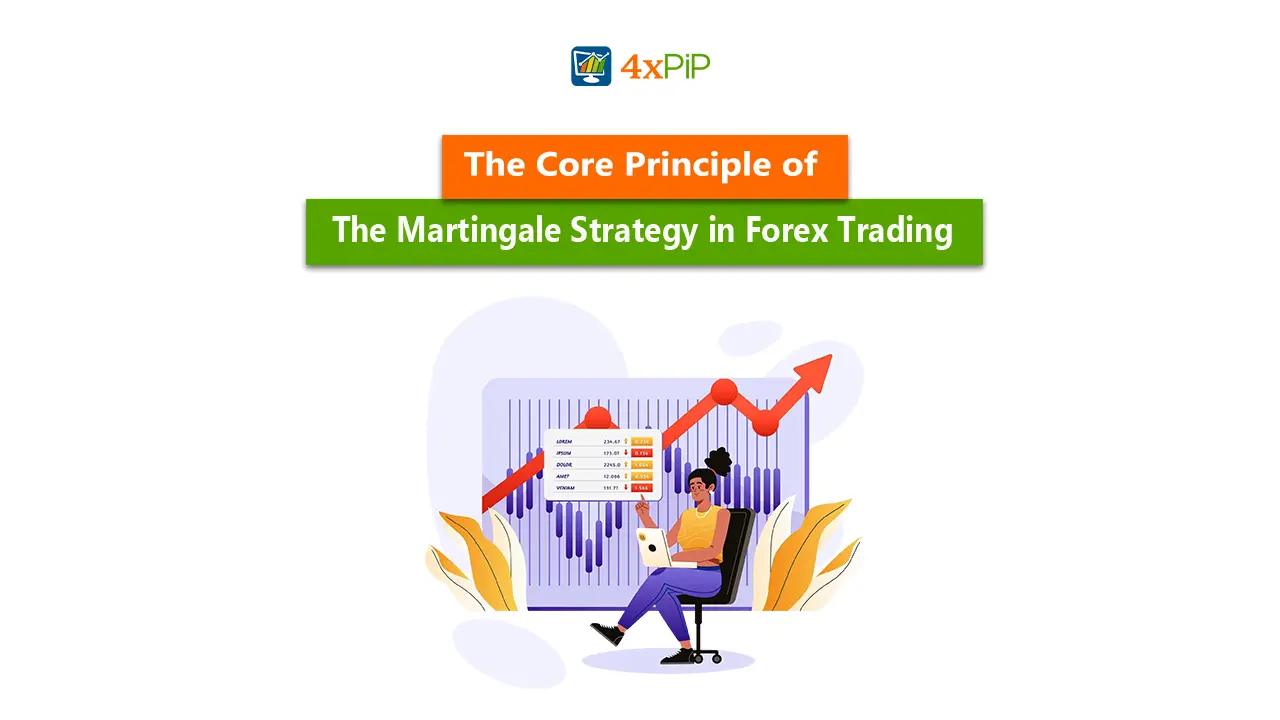
The Martingale strategy is rooted in a mathematical recovery principle, increasing position size after each losing trade so that a single winning position can recover all prior losses and yield a net profit. In Forex, this translates to a doubling pattern: if an initial 0.1 lot trade loses, the next trade opens at 0.2 lots, then 0.4, 0.8, and so on. This exponential increase allows the system to close all trades at a centralized profit target once price retraces. In theory, the logic ensures a 100% recovery rate, but in practice, it exposes traders to accelerating risk if the market trends persistently in one direction without reversal. That’s why capital management and spacing between trades are vital for long-term survival.
Through automation, this principle is executed with precision using our Best Martingale Strategy Forex EA. The EA automatically applies grid spacing (steps), multiplies lot size with each order, and manages a centralized take-profit that closes all active trades together in profit. To start, install the EA on your MetaTrader chart, set your initial lot size and multiplier, and define the maximum number of martingale orders based on your risk tolerance. The system will handle technical analysis, order sizing, and counter-trade execution automatically. While this logic optimizes recovery potential, traders should understand its natural limitation, exposure grows exponentially as volatility expands. Using equity stops and conservative multipliers helps balance reward symmetry with drawdown control.
How Market Volatility Impacts Martingale Performance
Volatility is the single biggest variable influencing how a Martingale strategy behaves. In calm markets, price oscillations remain narrow, meaning each averaging order is spaced farther apart in time and margin exposure increases gradually. The EA has enough room to recover drawdowns as small reversals often close grouped trades in profit. However, when volatility spikes, price swings expand, causing Martingale grids to fill faster. The higher order frequency increases lot sizes rapidly due to the multiplier effect, which accelerates margin consumption. This is why traders often experience deeper floating drawdowns during unstable sessions before the centralized take-profit level can reach recovery.
Sudden directional moves, like those during news releases or unexpected breakouts, can magnify this effect. If the market trends sharply without retracing, the Martingale system keeps adding counter trades until the max martingale orders limit is reached. This compounding behavior exposes the account to accelerated equity drops. For example, if a stable EUR/USD market moves within 25–40 pips, recovery might occur after two or three increments. In contrast, a volatile GBP/JPY move exceeding 100 pips can trigger the full sequence, stretching margin reserves and delaying profit closure.
At 4xPip, we address this volatility sensitivity by giving traders control over lot multipliers, grid spacing (steps), and stopout percentage. Adjusting these parameters based on volatility allows the Martingale system to operate sustainably. For instance, wider grid spacing during unstable markets reduces the number of active trades, while lowering the multiplier curbs exponential lot growth. By understanding how volatility interacts with order frequency and margin load, traders can fine-tune their Martingale EA to withstand turbulence instead of succumbing to it.
Understanding Drawdown and Its Relationship to Position Scaling
In quantitative terms, drawdown measures the percentage decline in equity from its peak to its lowest point during a trading sequence. For example, if an account grows to $10,000 and then drops to $8,000 before recovering, that’s a 20% drawdown. In Martingale systems, this metric becomes more important because of position scaling. Each new trade opens at a larger lot size, meaning every pip of adverse movement exerts a heavier impact on floating equity. Even when the overall strategy maintains a positive expectancy, compounded position sizing can magnify temporary drawdowns far beyond linear risk levels.
This is why monitoring both drawdown depth and duration is essential to evaluate any EA’s safety. A deep but short drawdown may be recoverable, while an extended one can cause margin exhaustion long before recovery levels are reached. To manage this effectively using the Forex Martingale EA explained by 4xPip, traders can fine-tune lot multipliers, max martingale orders, and stopout percentage directly from the settings panel. Here’s how: after installing the EA on your MetaTrader chart, open “Inputs” and set an initial lot size and a multiplier aligned with your capital. Adjust the stopout percentage to establish a safety threshold, this stops the system if losses exceed predefined limits. By controlling position scaling through these parameters, traders can maintain profitability while ensuring that equity drawdowns stay within acceptable ranges.
Using Equity Stops to Limit Catastrophic Losses
When market volatility accelerates and margin usage spikes, equity stops act as a fail-safe to prevent full-account wipeouts. They monitor the total account equity in real time and close all open positions once a predefined loss percentage is reached. This global stop ensures that even if individual trade stop-losses fail to trigger due to slippage or rapid price gaps, the overall account remains protected.
How equity stops function and why they matter:
- They trigger when account equity (balance + floating P/L) falls below a set percentage, automatically closing all trades.
- This mechanism prevents cascading losses during correlated trade drawdowns, a common scenario in grid or martingale strategies.
- Ideal for traders running multi-order EAs, where losses can accumulate across several open positions.
- Especially important in volatile pairs or during major news events where spreads widen and stop-losses can slip.
How to calculate realistic equity stop levels:
- Start by assessing average historical drawdown from your trading journal or EA backtests.
- Determine your maximum acceptable equity loss (e.g., 20%–30%) based on capital and trading frequency.
- Use ATR-based volatility filters to adjust the stop threshold dynamically, wider during high volatility, tighter during quiet markets.
- Re-evaluate equity stop levels whenever leverage, lot multiplier, or grid spacing is changed.
Balancing safety and opportunity:
- Too-tight stops may trigger premature closures during normal pullbacks, interrupting profitable recovery cycles.
- Too-loose stops expose the account to excessive drawdown and potential margin calls.
- The optimal stopout range lies between twice your average drawdown and half your total equity buffer.
- Use equity monitoring dashboards or built-in EA alerts to stay informed about approaching thresholds.
Our Forex Martingale EA already includes a stopout percentage parameter that automates these principles. Instead of manually watching equity levels, you can simply set your chosen percentage in the EA’s input settings. It will execute a full closeout once the defined limit is hit, preventing uncontrolled drawdowns while keeping your trading structure intact.
Optimizing Grid Spacing for Controlled Exposure
In Martingale-based systems, grid spacing represents the distance in pips between successive trade entries. It directly influences how frequently new positions are opened as the market moves against the initial trade. A well-calibrated grid spacing determines whether the system absorbs volatility effectively or accelerates into overexposure. Wider spacing places trades further apart, reducing the number of open orders and margin strain while extending recovery time. This configuration suits traders managing larger accounts or operating during volatile sessions, where price swings can trigger multiple unintended entries if spacing is too tight.
Tighter grid spacing, on the other hand, increases trade frequency and speeds up breakeven recovery during smaller retracements. However, this comes at the cost of higher cumulative exposure, especially when markets shift into strong directional trends. To maintain consistency, many traders align grid spacing with volatility indicators such as the Average True Range (ATR). For instance, expanding the grid distance during high volatility helps limit premature trades, while tightening it in calm market phases increases participation and short-term profitability. The goal is to keep grid logic adaptive rather than static, adjusting it in response to changing volatility ensures the Martingale system remains efficient and sustainable over time.
The Forex Martingale Strategy EA includes a built-in Steps parameter that automates grid spacing adjustments. Once installed on MetaTrader, users can simply specify the desired pip distance between orders, and the EA manages subsequent trade placement based on that configuration. When combined with volatility filters or ATR-based triggers, this setup ensures that grid exposure remains controlled even during unstable market periods, maintaining balance between drawdown recovery and capital preservation.
Adding Volatility Filters to Avoid Unstable Market Phases
Volatility filters play an important role in preventing Martingale systems from entering positions during erratic market conditions. They rely on technical metrics such as Average True Range (ATR) or Bollinger Band width to identify periods of heightened volatility and suspend trade initiation automatically. By filtering out such moments, traders can avoid overexposure during sudden price surges or news-driven spikes. This minimizes the risk of compounding losses that often occur when multiple Martingale orders trigger in unstable phases, ensuring that new positions are only opened when market behavior normalizes. In practice, volatility filters act as an additional layer of protection, keeping trading activity limited to times when spreads are stable, liquidity is consistent, and directional uncertainty can be accurately read.
In retrospect, our Forex Martingale EA added time and volatility filters to help traders maintain control even in unpredictable sessions. Once installed on MetaTrader, you can enable these filters to define which hours or volatility levels the bot is allowed to trade within. This configuration works effortlessly alongside equity stops and grid spacing parameters, forming a unified risk control framework. Together, they ensure that the EA pauses during volatile swings, limits exposure through dynamic grid spacing, and preserves account equity when the market becomes unstable, a balanced approach to sustainable Martingale automation built by our development team for traders who prioritize consistency over chance.
Summary
The Martingale Forex EA uses position scaling to recover losses by increasing trade size after each losing order. While this approach can generate steady profits in calm markets, it becomes highly sensitive to volatility and drawdown if left unmanaged. To build your own trading bot for MT4, MT5 or TradingView with long-term stability, traders must control exposure through tools like equity stops, optimized grid spacing, and volatility filters. These mechanisms work together to regulate risk, prevent compounding losses, and maintain margin safety. When integrated properly, a Martingale-based EA can evolve from a high-risk averaging system into a more sustainable automated strategy that balances recovery potential with capital protection.
4xPip Email Address: [email protected]
4xPip Telegram: https://t.me/pip_4x
4xPip Whatsapp: https://api.whatsapp.com/send/?phone=18382131588
FAQs
- What is a Forex Martingale EA?
A Forex Martingale EA is an automated system that doubles trade size after each loss to recover previous losses and close all positions at an overall profit once price retraces. - Why is market volatility important for Martingale strategies?
Volatility determines how quickly new trades are triggered. High volatility can cause the bot to open too many positions too fast, increasing drawdown and margin usage. - How does drawdown affect Martingale performance?
Drawdown reflects the drop in account equity during losing streaks. Because lot sizes increase exponentially, drawdowns grow faster in Martingale systems if markets trend without reversal. - What is grid spacing and why does it matter?
Grid spacing defines the pip distance between trades. Wider spacing reduces exposure and risk during volatile sessions, while tighter spacing accelerates recovery in calm markets. - How do equity stops protect a trading account?
Equity stops automatically close all trades once the account equity falls below a set percentage, preventing further loss during sudden price spikes or slippage. - What role do volatility filters play in automation?
Volatility filters use indicators like ATR or Bollinger Band width to pause trading during unstable conditions, helping avoid excessive entries and compounding losses. - Can a Martingale EA be made safer?
Yes. Adjusting multipliers, spacing, and equity stop parameters helps control exposure. Combining these settings with volatility filters enhances overall safety. - Why do traders lose with Martingale systems?
Most losses occur due to poor parameter setup, ignoring volatility, or trading without proper stopout protection, issues that amplify during strong market trends. - How can automation improve Martingale execution?
Automation removes emotional decision-making and executes recovery logic consistently. When coded with proper safeguards, it enhances precision and risk control. - What’s the best way to start with a Martingale EA?
Begin on a demo account, optimize grid and multiplier settings, and ensure equity stops are active. Traders can also work with expert developers to automate their strategy efficiently and safely.

